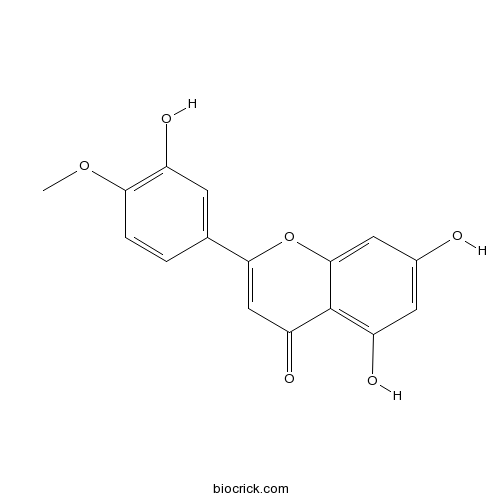Thlaspi arvense
Thlaspi arvense
1. The products in our compound library are selected from thousands of unique natural products; 2. It has the characteristics of diverse structure, diverse sources and wide coverage of activities; 3. Provide information on the activity of products from major journals, patents and research reports around the world, providing theoretical direction and research basis for further research and screening; 4. Free combination according to the type, source, target and disease of natural product; 5. The compound powder is placed in a covered tube and then discharged into a 10 x 10 cryostat; 6. Transport in ice pack or dry ice pack. Please store it at -20 °C as soon as possible after receiving the product, and use it as soon as possible after opening.
Natural products/compounds from Thlaspi arvense
- Cat.No. Product Name CAS Number COA
-
BCN2356
Diosmetin520-34-3
Instructions

Community response to a sustainable restoration plan for a superfund site.[Pubmed: 29626327]
Large-scale copper (Cu) mining activities in Michigan's Upper Peninsula produced millions of metric tons of mining wastes also known as stamp sands. The stamp sands containing high concentrations of Cu were disposed of into several lakes connected to the Lake Superior. Eventually, as aquatic organisms in these lakes started to exhibit toxicity symptoms, the stamp sands were dredged and discarded on the lake shores. Consequently, these areas turned into degraded, marginal lands and were collectively classified as a Torch Lake Superfund site by the US EPA. Due to the lack of vegetative cover, the Cu-rich stamp sands eroded into the lakes, affecting the aquatic life. To alleviate this issue, a sustainable restoration plan (SRP) was developed and tested in a greenhouse environment prior to field implementation. Cold-tolerant oilseed crops, camelina (Camelina sativa) and field pennycress (Thlaspi arvense), were grown on compost-fertilized stamp sands, which reduced soil erosion by acting as a vegetative cap. Oilseed plants produced normal yield, demonstrating their potential utilization as biofuel feedstock. Prior to implementing the SRP in field-scale in the Torch Lake Superfund site, a public opinion survey of the local community was conducted to understand the views of residents. Door-to-door survey was performed in July-August 2015, which yielded a response rate of 68.1%. Results showed that residents were generally concerned with stamp sand erosion into the Torch Lake and were overwhelmingly supportive of the SRP, which would not only provide environmental benefits but could boost the local economy via biofuel production. To gauge the general environmental awareness of the respondents, the survey included questions on climate change. Most of the respondents acknowledged that climate change is real and anthropogenically mediated. Having college education and a relatively high annual household income showed a positive and significant correlation with climate change awareness.
The pennycress (Thlaspi arvense L.) nectary: structural and transcriptomic characterization.[Pubmed: 29137608]
Pennycress [Thlaspi arvense L (Brassicaceae)] is being domesticated as a renewable biodiesel feedstock that also provides crucial ecosystems services, including as a nutritional resource for pollinators. However, its flowers produce significantly less nectar than other crop relatives in the Brassicaceae. This study was undertaken to understand the basic biology of the pennycress nectary as an initial step toward the possibility of enhancing nectar output from its flowers.
Anti-inflammatory effect of Man-Pen-Fang, a Chinese herbal compound, on chronic pelvic inflammation in rats.[Pubmed: 28652014]
Traditional Chinese Medicine (TCM) has become the focus of research for the treatment of chronic pelvic inflammatory disease (CPID) based on unique medical theory system. Man-Pen-Fang (MPF), a Chinese herbal compound, which is composed of Thlaspi arvense L. (Cruciferae), Gleditsia sinensis Lam. (Leguminosae), Smilax china L. (Liliaceae), Euonymus alatus (Thunb.) Sieb. (Celastraceae) and Vaccaria segetalis (Neck.) (Caryophyllaceae) MPF has been used for the treatment of CPID and exerted significant clinical curative effects. However, the corresponding active principles and anti-inflammatory mechanism of MPF are still unknown.
Seed Detection and Discrimination by Ground Beetles (Coleoptera: Carabidae) Are Associated with Olfactory Cues.[Pubmed: 28107464]
Olfactory ability is an element of fitness in many animals, guiding choices among alternatives such as mating partners or food. Ground beetles (Coleoptera; Carabidae), exhibit preferences for prey, and some species are well-known weed seed predators. We used olfactometer-based bioassays to determine if olfactory stimuli are associated with detection of Brassica napus L., Sinapis arvensis L., and Thlaspi arvense L. seeds by ground beetles characteristic of agroecosystems, and whether behavioural responses to seed odors depended on seed physiological state (imbibed or unimbibed). Imbibed B.napus seeds were preferred over other weed species by two of the three carabid species tested. Only A. littoralis responded significantly to unimbibed seeds of B. napus. Sensitivity to olfactory cues appeared to be highly specific as all carabid species discriminated between the olfactory cues of imbibed brassicaceous weed seeds, but did not discriminate between weed seeds that were unimbibed. Overall, our data suggest that depending on seed physiological state, odours can play an important role in the ability of carabids to find and recognize seeds of particular weed species.


